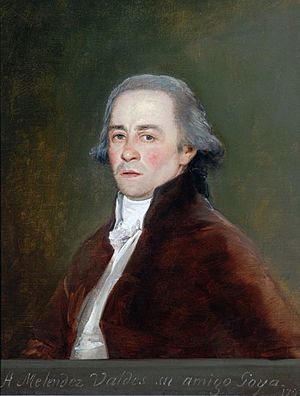Juan Meléndez Valdés facts for kids
Quick facts for kids
The Most Excellent
Juan Meléndez
|
|
|---|---|

Portrait by Francisco de Goya. circa 1797
|
|
| Born |
Juan Meléndez Valdés
11 March 1754 Ribera del Fresno, Spain
|
| Died | 24 May 1817 (aged 63) Montpellier, France
|
| Seat B of the Real Academia Española | |
| In office 16 July 1812 – 24 May 1817 |
|
| Preceded by | Joaquín Juan Flores |
| Succeeded by | Agustín de Silva y Palafox |
Juan Meléndez Valdés (born March 11, 1754 – died May 24, 1817) was an important Spanish poet. He lived during a time called the Enlightenment, which was a period of new ideas and ways of thinking. He is known for his "neoclassical" style of poetry, which means it was inspired by the art and ideas of ancient Greece and Rome.
Life of Juan Meléndez Valdés
Juan Meléndez Valdés was born in a town called Ribera del Fresno in Spain. His parents wanted him to become a priest. However, he decided to study law at the University of Salamanca. While there, he learned about new ideas from French thinkers.
Early Career and Poetry
In 1780, Juan Meléndez Valdés wrote a poem called Batilo. It was a pastoral poem, meaning it was about peaceful country life. This poem won a special prize from the Spanish academy. The next year, he met an important person named Jovellanos. Thanks to Jovellanos, Juan became a professor at Salamanca University in 1783.
He wrote another work called Las Bodas de Camacho (The Wedding of Camacho) in 1784. This play also had many pastoral scenes. It won a prize from the city of Madrid. In 1785, he published a collection of his poems. These poems were so good that people called him the best Spanish poet of his time.
Politics and Later Life
Because of his success, Juan Meléndez Valdés left his teaching job. He decided to try a career in politics. In 1789, his friend Jovellanos helped him get a job as a judge in Zaragoza. Two years later, he moved to a similar job in Valladolid.
In 1797, he published a bigger collection of his poems. He dedicated this book to Manuel de Godoy, a powerful Spanish leader. Juan tried to write poems like famous English poets John Milton and Thomson, but these were not as successful. Still, he was rewarded with a high position in the government's treasury department in Madrid.
When his friend Jovellanos lost power in 1798, Juan Meléndez Valdés was also removed from his job. He was sent away from the capital city. He returned to Madrid in 1808. In 1811, he accepted a job as a Minister of Public Instruction under Joseph Bonaparte. Joseph Bonaparte was the brother of Napoleon and was ruling Spain at the time. This decision upset many of his countrymen. Juan had previously written poems against the French ruler. Now, he praised him, which made many people angry.
In 1813, he had to leave Spain and fled to Alais in France. Around 1812, he also became a member of the Royal Spanish Academy. Four years later, in 1817, he passed away in Montpellier, France, without much money. His body was later moved back to Spain in 1866. Finally, in 1900, he was laid to rest in Madrid's "Panteón de Hombres Ilustres," a special place for famous Spanish people.
Many poets who came after him, like Manuel José Quintana, believed he was the best poet of the 1700s in Spain. People still think highly of his poetry today. He was also a close friend of the famous artist Francisco de Goya.
See also
 In Spanish: Juan Meléndez Valdés para niños
In Spanish: Juan Meléndez Valdés para niños

